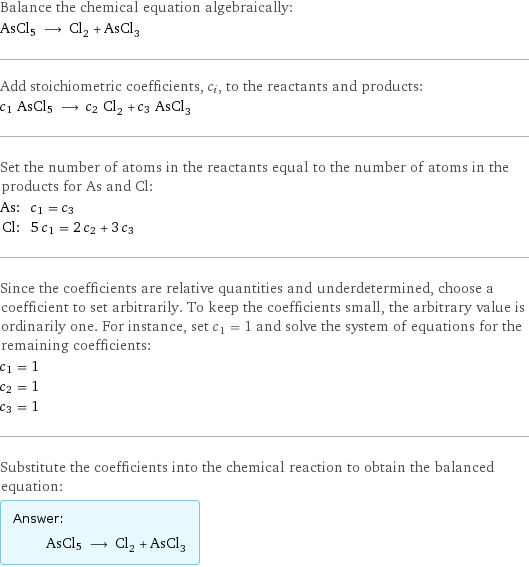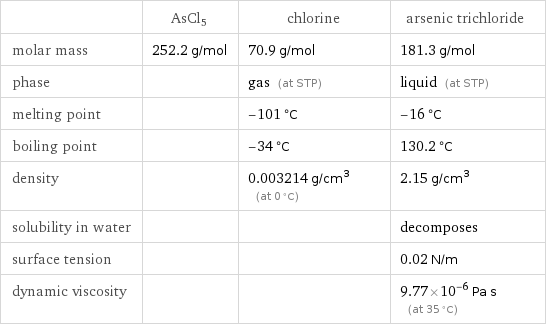Input interpretation

AsCl5 ⟶ Cl_2 chlorine + AsCl_3 arsenic trichloride
Balanced equation

Balance the chemical equation algebraically: AsCl5 ⟶ Cl_2 + AsCl_3 Add stoichiometric coefficients, c_i, to the reactants and products: c_1 AsCl5 ⟶ c_2 Cl_2 + c_3 AsCl_3 Set the number of atoms in the reactants equal to the number of atoms in the products for As and Cl: As: | c_1 = c_3 Cl: | 5 c_1 = 2 c_2 + 3 c_3 Since the coefficients are relative quantities and underdetermined, choose a coefficient to set arbitrarily. To keep the coefficients small, the arbitrary value is ordinarily one. For instance, set c_1 = 1 and solve the system of equations for the remaining coefficients: c_1 = 1 c_2 = 1 c_3 = 1 Substitute the coefficients into the chemical reaction to obtain the balanced equation: Answer: | | AsCl5 ⟶ Cl_2 + AsCl_3
Structures

AsCl5 ⟶ +
Names

AsCl5 ⟶ chlorine + arsenic trichloride
Equilibrium constant
![Construct the equilibrium constant, K, expression for: AsCl5 ⟶ Cl_2 + AsCl_3 Plan: • Balance the chemical equation. • Determine the stoichiometric numbers. • Assemble the activity expression for each chemical species. • Use the activity expressions to build the equilibrium constant expression. Write the balanced chemical equation: AsCl5 ⟶ Cl_2 + AsCl_3 Assign stoichiometric numbers, ν_i, using the stoichiometric coefficients, c_i, from the balanced chemical equation in the following manner: ν_i = -c_i for reactants and ν_i = c_i for products: chemical species | c_i | ν_i AsCl5 | 1 | -1 Cl_2 | 1 | 1 AsCl_3 | 1 | 1 Assemble the activity expressions accounting for the state of matter and ν_i: chemical species | c_i | ν_i | activity expression AsCl5 | 1 | -1 | ([AsCl5])^(-1) Cl_2 | 1 | 1 | [Cl2] AsCl_3 | 1 | 1 | [AsCl3] The equilibrium constant symbol in the concentration basis is: K_c Mulitply the activity expressions to arrive at the K_c expression: Answer: | | K_c = ([AsCl5])^(-1) [Cl2] [AsCl3] = ([Cl2] [AsCl3])/([AsCl5])](../image_source/59f409ec84f5d68e256bfa9b8d7a1852.png)
Construct the equilibrium constant, K, expression for: AsCl5 ⟶ Cl_2 + AsCl_3 Plan: • Balance the chemical equation. • Determine the stoichiometric numbers. • Assemble the activity expression for each chemical species. • Use the activity expressions to build the equilibrium constant expression. Write the balanced chemical equation: AsCl5 ⟶ Cl_2 + AsCl_3 Assign stoichiometric numbers, ν_i, using the stoichiometric coefficients, c_i, from the balanced chemical equation in the following manner: ν_i = -c_i for reactants and ν_i = c_i for products: chemical species | c_i | ν_i AsCl5 | 1 | -1 Cl_2 | 1 | 1 AsCl_3 | 1 | 1 Assemble the activity expressions accounting for the state of matter and ν_i: chemical species | c_i | ν_i | activity expression AsCl5 | 1 | -1 | ([AsCl5])^(-1) Cl_2 | 1 | 1 | [Cl2] AsCl_3 | 1 | 1 | [AsCl3] The equilibrium constant symbol in the concentration basis is: K_c Mulitply the activity expressions to arrive at the K_c expression: Answer: | | K_c = ([AsCl5])^(-1) [Cl2] [AsCl3] = ([Cl2] [AsCl3])/([AsCl5])
Rate of reaction
![Construct the rate of reaction expression for: AsCl5 ⟶ Cl_2 + AsCl_3 Plan: • Balance the chemical equation. • Determine the stoichiometric numbers. • Assemble the rate term for each chemical species. • Write the rate of reaction expression. Write the balanced chemical equation: AsCl5 ⟶ Cl_2 + AsCl_3 Assign stoichiometric numbers, ν_i, using the stoichiometric coefficients, c_i, from the balanced chemical equation in the following manner: ν_i = -c_i for reactants and ν_i = c_i for products: chemical species | c_i | ν_i AsCl5 | 1 | -1 Cl_2 | 1 | 1 AsCl_3 | 1 | 1 The rate term for each chemical species, B_i, is 1/ν_i(Δ[B_i])/(Δt) where [B_i] is the amount concentration and t is time: chemical species | c_i | ν_i | rate term AsCl5 | 1 | -1 | -(Δ[AsCl5])/(Δt) Cl_2 | 1 | 1 | (Δ[Cl2])/(Δt) AsCl_3 | 1 | 1 | (Δ[AsCl3])/(Δt) (for infinitesimal rate of change, replace Δ with d) Set the rate terms equal to each other to arrive at the rate expression: Answer: | | rate = -(Δ[AsCl5])/(Δt) = (Δ[Cl2])/(Δt) = (Δ[AsCl3])/(Δt) (assuming constant volume and no accumulation of intermediates or side products)](../image_source/0f625182f30374a7b2e5430e0682fb1b.png)
Construct the rate of reaction expression for: AsCl5 ⟶ Cl_2 + AsCl_3 Plan: • Balance the chemical equation. • Determine the stoichiometric numbers. • Assemble the rate term for each chemical species. • Write the rate of reaction expression. Write the balanced chemical equation: AsCl5 ⟶ Cl_2 + AsCl_3 Assign stoichiometric numbers, ν_i, using the stoichiometric coefficients, c_i, from the balanced chemical equation in the following manner: ν_i = -c_i for reactants and ν_i = c_i for products: chemical species | c_i | ν_i AsCl5 | 1 | -1 Cl_2 | 1 | 1 AsCl_3 | 1 | 1 The rate term for each chemical species, B_i, is 1/ν_i(Δ[B_i])/(Δt) where [B_i] is the amount concentration and t is time: chemical species | c_i | ν_i | rate term AsCl5 | 1 | -1 | -(Δ[AsCl5])/(Δt) Cl_2 | 1 | 1 | (Δ[Cl2])/(Δt) AsCl_3 | 1 | 1 | (Δ[AsCl3])/(Δt) (for infinitesimal rate of change, replace Δ with d) Set the rate terms equal to each other to arrive at the rate expression: Answer: | | rate = -(Δ[AsCl5])/(Δt) = (Δ[Cl2])/(Δt) = (Δ[AsCl3])/(Δt) (assuming constant volume and no accumulation of intermediates or side products)
Chemical names and formulas

| AsCl5 | chlorine | arsenic trichloride formula | AsCl5 | Cl_2 | AsCl_3 name | | chlorine | arsenic trichloride IUPAC name | | molecular chlorine | trichloroarsane
Substance properties

| AsCl5 | chlorine | arsenic trichloride molar mass | 252.2 g/mol | 70.9 g/mol | 181.3 g/mol phase | | gas (at STP) | liquid (at STP) melting point | | -101 °C | -16 °C boiling point | | -34 °C | 130.2 °C density | | 0.003214 g/cm^3 (at 0 °C) | 2.15 g/cm^3 solubility in water | | | decomposes surface tension | | | 0.02 N/m dynamic viscosity | | | 9.77×10^-6 Pa s (at 35 °C)
Units
